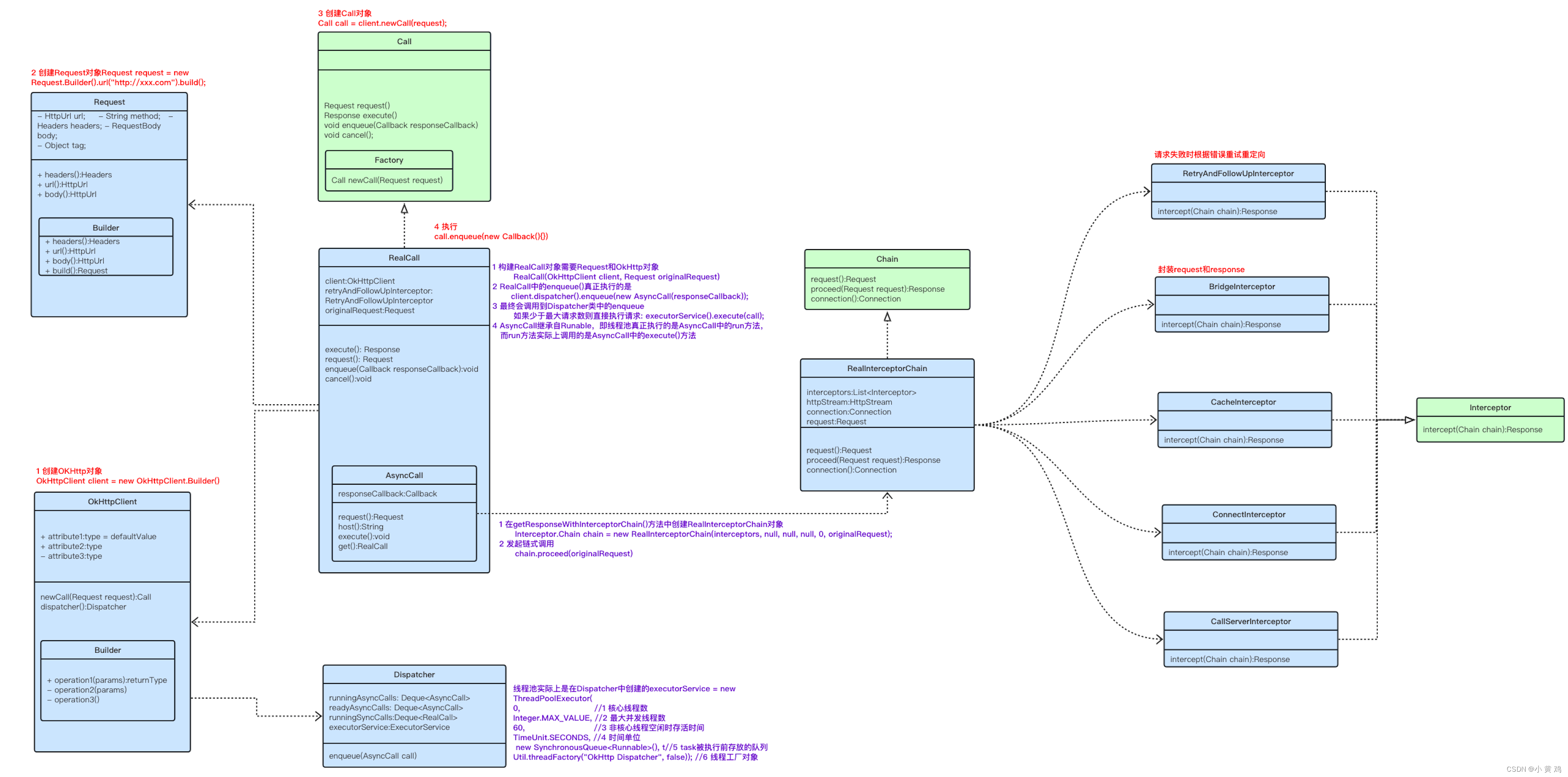OkHttp中的Request


1 Request
在RealCall中的内部类ApplicationInterceptorChain中
private final Request request;
在构造方法中,初始化了该request
ApplicationInterceptorChain(int index, Request request, boolean forWebSocket) {
this.index = index;
this.request = request;
this.forWebSocket = forWebSocket;
}
并在RealCall中的getResponseWithInterceptorChain方法中创建了该对象
private Response getResponseWithInterceptorChain(boolean forWebSocket) throws IOException {
Interceptor.Chain chain = new ApplicationInterceptorChain(0, originalRequest, forWebSocket);
return chain.proceed(originalRequest);
}
而RealCall中的originalRequest变量是在构造方法中被赋值的
protected RealCall(OkHttpClient client, Request originalRequest) {
this.client = client;
this.originalRequest = originalRequest;
}
也就是说,创建RealCall对象,需要Request对象。
2 RealCall
在OkHttpClient类中创建了RealCall
@Override public Call newCall(Request request) {
return new RealCall(this, request);
}
在OkHttpCall中,调用了该newCall方法。
private okhttp3.Call createRawCall() throws IOException {
Request request = serviceMethod.toRequest(args);
okhttp3.Call call = serviceMethod.callFactory.newCall(request);
if (call == null) {
throw new NullPointerException("Call.Factory returned null.");
}
return call;
}
接着看OkHttpCall中的args和serviceMethod的来源。
OkHttpCall(ServiceMethod<T> serviceMethod, Object[] args) {
this.serviceMethod = serviceMethod;
this.args = args;
}
可以追踪到在Retrofit中的create方法中
ServiceMethod serviceMethod = loadServiceMethod(method);
OkHttpCall okHttpCall = new OkHttpCall<>(serviceMethod, args);
OkHttpCall持有args和serviceMethod对象。通过createRawCall方法中的这一句,来创建了Request对象。
Request request = serviceMethod.toRequest(args);
在ServiceMethod的toRequest方法中,通过构建RequestBuilder,来创建Request对象。
Request toRequest(Object... args) throws IOException {
RequestBuilder requestBuilder = new RequestBuilder(httpMethod, baseUrl, relativeUrl, headers,
contentType, hasBody, isFormEncoded, isMultipart);
@SuppressWarnings("unchecked") // It is an error to invoke a method with the wrong arg types.
ParameterHandler<Object>[] handlers = (ParameterHandler<Object>[]) parameterHandlers;
int argumentCount = args != null ? args.length : 0;
if (argumentCount != handlers.length) {
throw new IllegalArgumentException("Argument count (" + argumentCount
+ ") doesn't match expected count (" + handlers.length + ")");
}
for (int p = 0; p < argumentCount; p++) {
handlers[p].apply(requestBuilder, args[p]);
}
return requestBuilder.build();
}
下面整体捋下思路。当在通过Retrofit执行下面这段代码时候,
MyApi api = retrofit.create(MyApi.class);
将会在Retrofit的create方法中创建ServiceMethod对象。并根据此对象和方法参数args来构建OkHttpCall对象。
3 Call.enqueue()
当执行下面这段代码时候
call.enqueue(new Callback<String>() {
@Override
public void onResponse(Call<String> call, Response<String> response) {
}
@Override
public void onFailure(Call<String> call, Throwable t) {
}
});
将会调用OkHttpCall中的enqueue方法。在此方法中首先会根据ServiceMethod对象和args来创建Request对象,再根据Request来创建RealCall对象。当执行OkHttpCall中的enqueue方法时,将会执行RealCall中的enqueue方法。
void enqueue(Callback responseCallback, boolean forWebSocket) {
synchronized (this) {
if (executed) throw new IllegalStateException("Already Executed");
executed = true;
}
client.dispatcher().enqueue(new AsyncCall(responseCallback, forWebSocket));
}
此方法会调用Dispatcher类中的enqueue()方法
synchronized void enqueue(AsyncCall call) {
if (runningAsyncCalls.size() < maxRequests && runningCallsForHost(call) < maxRequestsPerHost) {
runningAsyncCalls.add(call);
executorService().execute(call);
} else {
readyAsyncCalls.add(call);
}
}
Dispatcher类中持有线程池。直接通过线程池,来执行任务。
4 AsyncCall
首先来看AsyncCall的继承结构
AsyncCall extends NamedRunnable extends Runnable
在NamedRunnable中
protected abstract void execute();
所以Dispatcher中线程池执行的任务其实是AsyncCall中的execute()方法中的内容
在AsyncCall的execute()方法中
@Override protected void execute() {
boolean signalledCallback = false;
try {
Response response = getResponseWithInterceptorChain(forWebSocket);
} catch (IOException e) {
} finally {
client.dispatcher().finished(this);
}
}
上段代码中调用了RealCall中的getResponseWithInterceptorChain()方法。
在RealCall中有:
private Response getResponseWithInterceptorChain(boolean forWebSocket) throws IOException {
Interceptor.Chain chain = new ApplicationInterceptorChain(0, originalRequest, forWebSocket);
return chain.proceed(originalRequest);
}
上段代码调用了RealCall的内部类ApplicationInterceptorChain中的proceed()方法。
在ApplicationInterceptorChain中有:
@Override public Response proceed(Request request) throws IOException {
// If there's another interceptor in the chain, call that.
if (index < client.interceptors().size()) {
Interceptor.Chain chain = new ApplicationInterceptorChain(index + 1, request, forWebSocket);
Interceptor interceptor = client.interceptors().get(index);
Response interceptedResponse = interceptor.intercept(chain);
if (interceptedResponse == null) {
throw new NullPointerException("application interceptor " + interceptor
+ " returned null");
}
return interceptedResponse;
}
// No more interceptors. Do HTTP.
return getResponse(request, forWebSocket);
}
最后执行RealCall中的getResponse()方法
在RealCall中有:
Response getResponse(Request request, boolean forWebSocket) throws IOException {
RequestBody body = request.body();
if (body != null) {
Request.Builder requestBuilder = request.newBuilder();
MediaType contentType = body.contentType();
if (contentType != null) {
requestBuilder.header("Content-Type", contentType.toString());
}
long contentLength = body.contentLength();
if (contentLength != -1) {
requestBuilder.header("Content-Length", Long.toString(contentLength));
requestBuilder.removeHeader("Transfer-Encoding");
} else {
requestBuilder.header("Transfer-Encoding", "chunked");
requestBuilder.removeHeader("Content-Length");
}
//1 创建request对象
request = requestBuilder.build();
}
//2 创建HttpEngine
engine = new HttpEngine(client, request, false, false, forWebSocket, null, null, null);
int followUpCount = 0;
while (true) {
if (canceled) {
//3 如果取消了 释放engine
engine.releaseStreamAllocation();
throw new IOException("Canceled");
}
boolean releaseConnection = true;
try {
//4 发送请求
engine.sendRequest();
engine.readResponse();
releaseConnection = false;
} catch (RequestException e) {
// The attempt to interpret the request failed. Give up.
throw e.getCause();
} catch (RouteException e) {
// The attempt to connect via a route failed. The request will not have been sent.
HttpEngine retryEngine = engine.recover(e.getLastConnectException(), true, null);
if (retryEngine != null) {
releaseConnection = false;
engine = retryEngine;
continue;
}
// Give up; recovery is not possible.
throw e.getLastConnectException();
} catch (IOException e) {
// An attempt to communicate with a server failed. The request may have been sent.
HttpEngine retryEngine = engine.recover(e, false, null);
if (retryEngine != null) {
releaseConnection = false;
engine = retryEngine;
continue;
}
// Give up; recovery is not possible.
throw e;
} finally {
// We're throwing an unchecked exception. Release any resources.
if (releaseConnection) {
StreamAllocation streamAllocation = engine.close();
streamAllocation.release();
}
}
Response response = engine.getResponse();
Request followUp = engine.followUpRequest();
if (followUp == null) {
if (!forWebSocket) {
engine.releaseStreamAllocation();
}
return response;
}
StreamAllocation streamAllocation = engine.close();
if (++followUpCount > MAX_FOLLOW_UPS) {
streamAllocation.release();
throw new ProtocolException("Too many follow-up requests: " + followUpCount);
}
if (!engine.sameConnection(followUp.url())) {
streamAllocation.release();
streamAllocation = null;
} else if (streamAllocation.stream() != null) {
throw new IllegalStateException("Closing the body of " + response
+ " didn't close its backing stream. Bad interceptor?");
}
request = followUp;
engine = new HttpEngine(client, request, false, false, forWebSocket, streamAllocation, null,
response);
}
}






















 1830
1830











 被折叠的 条评论
为什么被折叠?
被折叠的 条评论
为什么被折叠?








